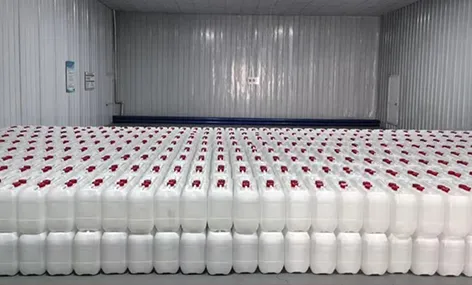
Jul . 10, 2025 14:32 Back to list
The Connection and Value of Acetic Acid
In the field of chemical engineering, Acetic Acid Glacial Acetic Acid often appears simultaneously. Although the two are closely related, they play unique roles in different scenarios due to their differences in form and properties. As important organic compounds, they are like "twin flowers", interrelated and possessing unique characteristics, profoundly influencing industrial production and daily life.

From a chemical perspective, Acetic Acid Glacial Acetic Acid is composed of acetic acid as its core component
Acetic acid usually refers to an aqueous solution of acetic acid with a concentration below 100%. Common edible vinegar is a diluted solution containing about 3% and 5% acetic acid; And glacial acetic acid is the common name for anhydrous acetic acid, with a purity of over 99.5%. It is named after the fact that acoh glacial condenses into ice like crystals below 16.6 ℃. This purity difference determines significant differences in physical properties and chemical activity between the two.
In terms of physical properties, Acetic Acid exhibits completely different characteristics
Acetic acid contains a large amount of water, has strong fluidity, and a relatively mild odor; And glacial acetic acid has higher density and viscosity, stronger volatility, and emits a pungent and strong sour taste. In addition, the freezing point of glacial acetic acid is significantly higher than that of diluted acetic acid solution, and it is highly prone to crystallization in low-temperature environments. This characteristic requires special attention to temperature control during storage and transportation to avoid container damage or inconvenience caused by solidification.
The division of labor between acetic acid and glassy acetic acid in the application field is also very clear
Acetic acid, due to its mild acidity and safety, is widely used in the food industry, such as as as an acidity regulator in beverages, cans, and seasonings. It can not only impart unique flavors to food, but also inhibit microbial growth and extend shelf life; In the field of medicine, low concentration acetic acid can be used as an external preparation for the skin, exerting antibacterial and disinfectant effects. In contrast, anhydrous acetic acid has become a key raw material for chemical synthesis due to its high purity and strong acidity, and is commonly used to prepare high-value chemicals such as vinyl acetate and acetic anhydride; In the printing and dyeing industry, glacial acetic acid can adjust the pH value of the dye solution and improve the dye fixation effect; In leather processing, it is used as a tanning agent to enhance the softness and durability of leather.
Safe use of Acetic Acid Glacial Acetic Acid cannot be ignored
Although the concentration of acetic acid is low, it still has a certain degree of corrosiveness and needs to be rinsed promptly when in contact with the skin or eyes; Conc acetic acid is more dangerous due to its strong corrosiveness. Once in contact with the human body, it can cause serious burns, and inhaling steam may also damage the respiratory tract. Therefore, when using glacial acetic acid, professional protective equipment such as chemical protective clothing, goggles, and gas masks must be equipped, and the operating environment must be well ventilated. In addition, glacial acetic acid is flammable and should be stored away from sources of fire and heat to avoid mixing with strong oxidants.
In summary, although acetic acid belongs to the acetic acid family, it blooms like a "twin flower" in different fields. Acetic acid, with its mild properties, is closely related to daily life and contributes to food seasoning and healthcare; Conc acetic acid has become the "backbone" of chemical production due to its high purity and strong activity. Whether it is to meet the needs of people's livelihoods or to promote industrial development, the two complement each other and jointly build a complete application chain from daily life to high-end manufacturing, occupying an irreplaceable and important position in the chemical industry.
Acetic Acid Glacial Acetic Acid FAQs
What is the difference between Acetic Acid and Glacial Acetic Acid?
Acetic acid is an aqueous solution of pure acetic acid (CH3 COOH), typically with a concentration of 5% to 10% (such as vinegar); Acid glass is anhydrous acetic acid (concentration ≥ 99.5%), named after its solidification into ice like crystals at low temperatures.
Why is acid glass called "glass"?
Due to its high purity (close to 100%), it forms an icy solid at low temperatures (below 16.6 ° C), hence the name "glassy" (meaning "icy").
What are the main uses of acid glass?
Chemical synthesis: Production of vinyl acetate, cellulose acetate, etc.
Laboratory: Used as a solvent or pH adjusting reagent.
Industry: Used for textile dyeing, rubber processing, etc.
Family: Diluted can be used as a descaling agent (caution should be exercised when handling).
What are the safety risks of acid glass?
Corrosive: Direct contact can burn the skin, eyes, and respiratory tract.
Volatility: Inhaling its vapor may cause coughing or difficulty breathing.
Operation requirements: Use in a fume hood, wear protective gloves and goggles.
How to dilute acid glass?
Be sure to slowly add acid glass to the water (rather than reverse operation) to avoid splashing caused by intense heat release. For example, when preparing a 1M solution, pour 57mL of acid glass into approximately 800mL of water and then dilute to 1L.
-
The Connection and Value of Acetic Acid
NewsJul.10,2025
-
The Application of Glacial Acetic Acid in Industrial, Food, Pharmaceutical and Other Fields
NewsJul.10,2025
-
Security points of Glacial Acetic Acid Nfpa
NewsJul.10,2025
-
Glacial Ethanoic Acid: The 'Versatile' and 'Dangerous Elf' of the Chemical Industry
NewsJul.10,2025
-
Formation Principle and Special Properties of Frozen Glassy Acetic Acid
NewsJul.10,2025
-
Application of Concentrated Glacial Acetic Acid in Chemical, Pharmaceutical, Food and Other Fields
NewsJul.10,2025
